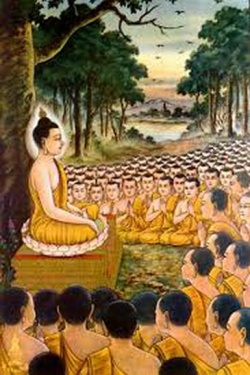Difference between revisions of "Pravrajyā"
| (2 intermediate revisions by 2 users not shown) | |||
| Line 2: | Line 2: | ||
[[pravrajyā]] refers to the [[admission of a novice]] | [[pravrajyā]] refers to the [[admission of a novice]] | ||
| − | [[pabbajjā]], ( [[Pāli]]: “[[to wander forth]]”: ) [[Sanskrit]] [[Pravrajyā]], [[Buddhist]] [[rite]] of [[ordination]] by which a layman becomes a {{Wiki|novice}} (Pāli [[sāmaṇera]]; Sanskrit [[śrāmaṇera]]). The ceremony is also the preliminary part of higher [[ordination]], raising a [[novice]] to a [[monk]] (see [[upasaṃpadā]]). | + | [[pabbajjā]], ( [[Pāli]]: “[[to wander forth]]”: ) [[Sanskrit]] [[Pravrajyā]], [[Buddhist]] [[rite]] of [[ordination]] by which a [[layman]] becomes a {{Wiki|novice}} ([[Pāli]] [[sāmaṇera]]; [[Sanskrit]] [[śrāmaṇera]]). The {{Wiki|ceremony}} is also the preliminary part of higher [[ordination]], raising a [[novice]] to a [[monk]] (see [[upasaṃpadā]]). |
| − | In some [[Theravāda]] countries such as [[Burma]], the rite is normally held for every [[Buddhist]] boy at the age of puberty. In {{Wiki|Tibet}} and {{Wiki|China}} a probationary period of study is required before the candidate becomes a [[novice]], during which he does not receive tonsure and is not exempt from military service. | + | In some [[Theravāda]] countries such as [[Burma]], the [[rite]] is normally held for every [[Buddhist]] boy at the age of puberty. In {{Wiki|Tibet}} and {{Wiki|China}} a probationary period of study is required before the candidate becomes a [[novice]], during which he does not receive tonsure and is not exempt from {{Wiki|military}} service. |
| − | Details of the ceremony vary from country to country. In most instances, the candidate appears before an assembly of 10 (in some cases fewer) [[ordained]] [[monks]] and asks for admission to the order as a [[novice]]. His head and face are shaved, and he presents the upper and lower robes of the novice for consecration by the officiating {{Wiki|abbot}} or senior [[monk]]. The candidate puts on the {{Wiki|monastic}} robes and returns. He then asks for the [[Threefold Refuge]] (in the [[Buddha]], the teaching, and the [[order]]) and the 10 precepts (ethical code; see [[sīla]]) to be administered to him. The [[rite]] is concluded with his obeisance to the senior [[monks]] and his request for forgiveness of his faults. | + | Details of the {{Wiki|ceremony}} vary from country to country. In most instances, the candidate appears before an assembly of 10 (in some cases fewer) [[ordained]] [[monks]] and asks for admission to the [[order]] as a [[novice]]. His {{Wiki|head}} and face are shaved, and he presents the upper and lower [[robes]] of the [[novice]] for [[consecration]] by the officiating {{Wiki|abbot}} or {{Wiki|senior}} [[monk]]. The candidate puts on the {{Wiki|monastic}} [[robes]] and returns. He then asks for the [[Threefold Refuge]] (in the [[Buddha]], the [[teaching]], and the [[order]]) and the [[10 precepts]] ([[ethical]] code; see [[sīla]]) to be administered to him. The [[rite]] is concluded with his obeisance to the {{Wiki|senior}} [[monks]] and his request for [[forgiveness]] of his faults. |
| − | The [[novice]] lives in the [[monastery]] for a period varying from a few days to several months and accompanies the [[monk]] on the daily alms rounds, but he is not allowed to participate in the fortnightly recitation of the [[patimokkha]] (the rules of monastic discipline). | + | The [[novice]] [[lives]] in the [[monastery]] for a period varying from a few days to several months and accompanies the [[monk]] on the daily [[alms]] rounds, but he is not allowed to participate in the fortnightly {{Wiki|recitation}} of the [[patimokkha]] (the {{Wiki|rules}} of [[monastic]] [[discipline]]). |
{{R}} | {{R}} | ||
[http://www.britannica.com/EBchecked/topic/437420/pabbajja www.britannica.com] | [http://www.britannica.com/EBchecked/topic/437420/pabbajja www.britannica.com] | ||
| − | + | {{PaliTerminology}} | |
[[Category:Sanskrit terminology]] | [[Category:Sanskrit terminology]] | ||
[[Category:Sangha]] | [[Category:Sangha]] | ||
Latest revision as of 19:04, 8 March 2015
pravrajyā refers to the admission of a novice
pabbajjā, ( Pāli: “to wander forth”: ) Sanskrit Pravrajyā, Buddhist rite of ordination by which a layman becomes a novice (Pāli sāmaṇera; Sanskrit śrāmaṇera). The ceremony is also the preliminary part of higher ordination, raising a novice to a monk (see upasaṃpadā).
In some Theravāda countries such as Burma, the rite is normally held for every Buddhist boy at the age of puberty. In Tibet and China a probationary period of study is required before the candidate becomes a novice, during which he does not receive tonsure and is not exempt from military service.
Details of the ceremony vary from country to country. In most instances, the candidate appears before an assembly of 10 (in some cases fewer) ordained monks and asks for admission to the order as a novice. His head and face are shaved, and he presents the upper and lower robes of the novice for consecration by the officiating abbot or senior monk. The candidate puts on the monastic robes and returns. He then asks for the Threefold Refuge (in the Buddha, the teaching, and the order) and the 10 precepts (ethical code; see sīla) to be administered to him. The rite is concluded with his obeisance to the senior monks and his request for forgiveness of his faults.
The novice lives in the monastery for a period varying from a few days to several months and accompanies the monk on the daily alms rounds, but he is not allowed to participate in the fortnightly recitation of the patimokkha (the rules of monastic discipline).
